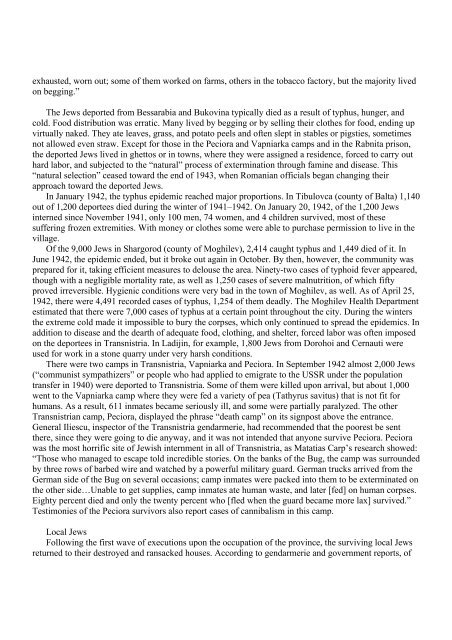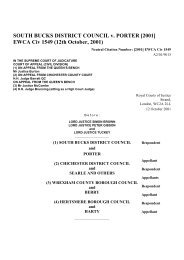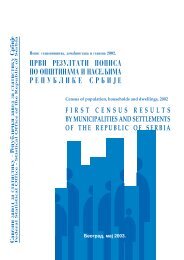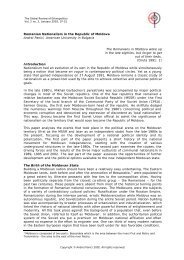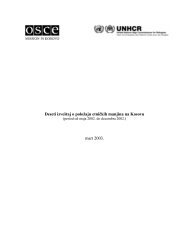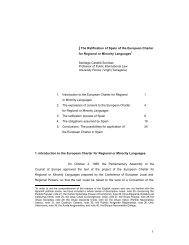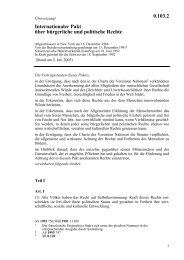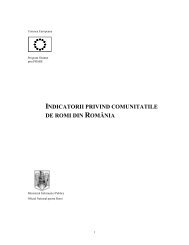Final Report of the International Commission on the - Minority Rights ...
Final Report of the International Commission on the - Minority Rights ...
Final Report of the International Commission on the - Minority Rights ...
Create successful ePaper yourself
Turn your PDF publications into a flip-book with our unique Google optimized e-Paper software.
exhausted, worn out; some <str<strong>on</strong>g>of</str<strong>on</strong>g> <str<strong>on</strong>g>the</str<strong>on</strong>g>m worked <strong>on</strong> farms, o<str<strong>on</strong>g>the</str<strong>on</strong>g>rs in <str<strong>on</strong>g>the</str<strong>on</strong>g> tobacco factory, but <str<strong>on</strong>g>the</str<strong>on</strong>g> majority lived<br />
<strong>on</strong> begging.”<br />
The Jews deported from Bessarabia and Bukovina typically died as a result <str<strong>on</strong>g>of</str<strong>on</strong>g> typhus, hunger, and<br />
cold. Food distributi<strong>on</strong> was erratic. Many lived by begging or by selling <str<strong>on</strong>g>the</str<strong>on</strong>g>ir clo<str<strong>on</strong>g>the</str<strong>on</strong>g>s for food, ending up<br />
virtually naked. They ate leaves, grass, and potato peels and <str<strong>on</strong>g>of</str<strong>on</strong>g>ten slept in stables or pigsties, sometimes<br />
not allowed even straw. Except for those in <str<strong>on</strong>g>the</str<strong>on</strong>g> Peciora and Vapniarka camps and in <str<strong>on</strong>g>the</str<strong>on</strong>g> Rabnita pris<strong>on</strong>,<br />
<str<strong>on</strong>g>the</str<strong>on</strong>g> deported Jews lived in ghettos or in towns, where <str<strong>on</strong>g>the</str<strong>on</strong>g>y were assigned a residence, forced to carry out<br />
hard labor, and subjected to <str<strong>on</strong>g>the</str<strong>on</strong>g> “natural” process <str<strong>on</strong>g>of</str<strong>on</strong>g> exterminati<strong>on</strong> through famine and disease. This<br />
“natural selecti<strong>on</strong>” ceased toward <str<strong>on</strong>g>the</str<strong>on</strong>g> end <str<strong>on</strong>g>of</str<strong>on</strong>g> 1943, when Romanian <str<strong>on</strong>g>of</str<strong>on</strong>g>ficials began changing <str<strong>on</strong>g>the</str<strong>on</strong>g>ir<br />
approach toward <str<strong>on</strong>g>the</str<strong>on</strong>g> deported Jews.<br />
In January 1942, <str<strong>on</strong>g>the</str<strong>on</strong>g> typhus epidemic reached major proporti<strong>on</strong>s. In Tibulovca (county <str<strong>on</strong>g>of</str<strong>on</strong>g> Balta) 1,140<br />
out <str<strong>on</strong>g>of</str<strong>on</strong>g> 1,200 deportees died during <str<strong>on</strong>g>the</str<strong>on</strong>g> winter <str<strong>on</strong>g>of</str<strong>on</strong>g> 1941–1942. On January 20, 1942, <str<strong>on</strong>g>of</str<strong>on</strong>g> <str<strong>on</strong>g>the</str<strong>on</strong>g> 1,200 Jews<br />
interned since November 1941, <strong>on</strong>ly 100 men, 74 women, and 4 children survived, most <str<strong>on</strong>g>of</str<strong>on</strong>g> <str<strong>on</strong>g>the</str<strong>on</strong>g>se<br />
suffering frozen extremities. With m<strong>on</strong>ey or clo<str<strong>on</strong>g>the</str<strong>on</strong>g>s some were able to purchase permissi<strong>on</strong> to live in <str<strong>on</strong>g>the</str<strong>on</strong>g><br />
village.<br />
Of <str<strong>on</strong>g>the</str<strong>on</strong>g> 9,000 Jews in Shargorod (county <str<strong>on</strong>g>of</str<strong>on</strong>g> Moghilev), 2,414 caught typhus and 1,449 died <str<strong>on</strong>g>of</str<strong>on</strong>g> it. In<br />
June 1942, <str<strong>on</strong>g>the</str<strong>on</strong>g> epidemic ended, but it broke out again in October. By <str<strong>on</strong>g>the</str<strong>on</strong>g>n, however, <str<strong>on</strong>g>the</str<strong>on</strong>g> community was<br />
prepared for it, taking efficient measures to delouse <str<strong>on</strong>g>the</str<strong>on</strong>g> area. Ninety-two cases <str<strong>on</strong>g>of</str<strong>on</strong>g> typhoid fever appeared,<br />
though with a negligible mortality rate, as well as 1,250 cases <str<strong>on</strong>g>of</str<strong>on</strong>g> severe malnutriti<strong>on</strong>, <str<strong>on</strong>g>of</str<strong>on</strong>g> which fifty<br />
proved irreversible. Hygienic c<strong>on</strong>diti<strong>on</strong>s were very bad in <str<strong>on</strong>g>the</str<strong>on</strong>g> town <str<strong>on</strong>g>of</str<strong>on</strong>g> Moghilev, as well. As <str<strong>on</strong>g>of</str<strong>on</strong>g> April 25,<br />
1942, <str<strong>on</strong>g>the</str<strong>on</strong>g>re were 4,491 recorded cases <str<strong>on</strong>g>of</str<strong>on</strong>g> typhus, 1,254 <str<strong>on</strong>g>of</str<strong>on</strong>g> <str<strong>on</strong>g>the</str<strong>on</strong>g>m deadly. The Moghilev Health Department<br />
estimated that <str<strong>on</strong>g>the</str<strong>on</strong>g>re were 7,000 cases <str<strong>on</strong>g>of</str<strong>on</strong>g> typhus at a certain point throughout <str<strong>on</strong>g>the</str<strong>on</strong>g> city. During <str<strong>on</strong>g>the</str<strong>on</strong>g> winters<br />
<str<strong>on</strong>g>the</str<strong>on</strong>g> extreme cold made it impossible to bury <str<strong>on</strong>g>the</str<strong>on</strong>g> corpses, which <strong>on</strong>ly c<strong>on</strong>tinued to spread <str<strong>on</strong>g>the</str<strong>on</strong>g> epidemics. In<br />
additi<strong>on</strong> to disease and <str<strong>on</strong>g>the</str<strong>on</strong>g> dearth <str<strong>on</strong>g>of</str<strong>on</strong>g> adequate food, clothing, and shelter, forced labor was <str<strong>on</strong>g>of</str<strong>on</strong>g>ten imposed<br />
<strong>on</strong> <str<strong>on</strong>g>the</str<strong>on</strong>g> deportees in Transnistria. In Ladijin, for example, 1,800 Jews from Dorohoi and Cernauti were<br />
used for work in a st<strong>on</strong>e quarry under very harsh c<strong>on</strong>diti<strong>on</strong>s.<br />
There were two camps in Transnistria, Vapniarka and Peciora. In September 1942 almost 2,000 Jews<br />
(“communist sympathizers” or people who had applied to emigrate to <str<strong>on</strong>g>the</str<strong>on</strong>g> USSR under <str<strong>on</strong>g>the</str<strong>on</strong>g> populati<strong>on</strong><br />
transfer in 1940) were deported to Transnistria. Some <str<strong>on</strong>g>of</str<strong>on</strong>g> <str<strong>on</strong>g>the</str<strong>on</strong>g>m were killed up<strong>on</strong> arrival, but about 1,000<br />
went to <str<strong>on</strong>g>the</str<strong>on</strong>g> Vapniarka camp where <str<strong>on</strong>g>the</str<strong>on</strong>g>y were fed a variety <str<strong>on</strong>g>of</str<strong>on</strong>g> pea (Tathyrus savitus) that is not fit for<br />
humans. As a result, 611 inmates became seriously ill, and some were partially paralyzed. The o<str<strong>on</strong>g>the</str<strong>on</strong>g>r<br />
Transnistrian camp, Peciora, displayed <str<strong>on</strong>g>the</str<strong>on</strong>g> phrase “death camp” <strong>on</strong> its signpost above <str<strong>on</strong>g>the</str<strong>on</strong>g> entrance.<br />
General Iliescu, inspector <str<strong>on</strong>g>of</str<strong>on</strong>g> <str<strong>on</strong>g>the</str<strong>on</strong>g> Transnistria gendarmerie, had recommended that <str<strong>on</strong>g>the</str<strong>on</strong>g> poorest be sent<br />
<str<strong>on</strong>g>the</str<strong>on</strong>g>re, since <str<strong>on</strong>g>the</str<strong>on</strong>g>y were going to die anyway, and it was not intended that any<strong>on</strong>e survive Peciora. Peciora<br />
was <str<strong>on</strong>g>the</str<strong>on</strong>g> most horrific site <str<strong>on</strong>g>of</str<strong>on</strong>g> Jewish internment in all <str<strong>on</strong>g>of</str<strong>on</strong>g> Transnistria, as Matatias Carp’s research showed:<br />
“Those who managed to escape told incredible stories. On <str<strong>on</strong>g>the</str<strong>on</strong>g> banks <str<strong>on</strong>g>of</str<strong>on</strong>g> <str<strong>on</strong>g>the</str<strong>on</strong>g> Bug, <str<strong>on</strong>g>the</str<strong>on</strong>g> camp was surrounded<br />
by three rows <str<strong>on</strong>g>of</str<strong>on</strong>g> barbed wire and watched by a powerful military guard. German trucks arrived from <str<strong>on</strong>g>the</str<strong>on</strong>g><br />
German side <str<strong>on</strong>g>of</str<strong>on</strong>g> <str<strong>on</strong>g>the</str<strong>on</strong>g> Bug <strong>on</strong> several occasi<strong>on</strong>s; camp inmates were packed into <str<strong>on</strong>g>the</str<strong>on</strong>g>m to be exterminated <strong>on</strong><br />
<str<strong>on</strong>g>the</str<strong>on</strong>g> o<str<strong>on</strong>g>the</str<strong>on</strong>g>r side…Unable to get supplies, camp inmates ate human waste, and later [fed] <strong>on</strong> human corpses.<br />
Eighty percent died and <strong>on</strong>ly <str<strong>on</strong>g>the</str<strong>on</strong>g> twenty percent who [fled when <str<strong>on</strong>g>the</str<strong>on</strong>g> guard became more lax] survived.”<br />
Testim<strong>on</strong>ies <str<strong>on</strong>g>of</str<strong>on</strong>g> <str<strong>on</strong>g>the</str<strong>on</strong>g> Peciora survivors also report cases <str<strong>on</strong>g>of</str<strong>on</strong>g> cannibalism in this camp.<br />
Local Jews<br />
Following <str<strong>on</strong>g>the</str<strong>on</strong>g> first wave <str<strong>on</strong>g>of</str<strong>on</strong>g> executi<strong>on</strong>s up<strong>on</strong> <str<strong>on</strong>g>the</str<strong>on</strong>g> occupati<strong>on</strong> <str<strong>on</strong>g>of</str<strong>on</strong>g> <str<strong>on</strong>g>the</str<strong>on</strong>g> province, <str<strong>on</strong>g>the</str<strong>on</strong>g> surviving local Jews<br />
returned to <str<strong>on</strong>g>the</str<strong>on</strong>g>ir destroyed and ransacked houses. According to gendarmerie and government reports, <str<strong>on</strong>g>of</str<strong>on</strong>g>


